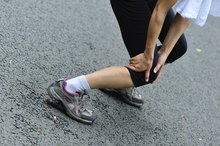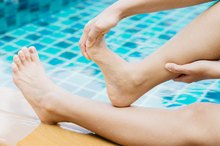What Are the Treatments for Muscle Pain After a Tetanus Shot?
Being exposed to certain bacteria when a cut or wound occurs can cause a disease called tetanus, or lockjaw. This disease leads to all over muscle pain and tightness, locking of the jaw that inhibits the ability to open the mouth and swallow and, in some cases, death. Tetanus shots can help to prevent this disease. While tetanus shots are well tolerated by most, there can be a variety of side effects including muscle pain. If this occurs, there are some treatments that can be tried.
If you are experiencing serious medical symptoms, seek emergency treatment immediately.
Pain Medication
Within hours or days after receiving a tetanus shot, the area around the shot may become red, swollen or painful. In rare cases, muscle pain may spread to other areas of the body. Talk to your health care provider about taking an over-the-counter pain reliever to decrease this pain 3. A physician can suggest the best pain reliever and dosage based on your age, general health and other medications that are being taken. In some people, taking pain relievers can reduce the effectiveness of the vaccine 3. In most cases, pain relievers are only needed for one to two days after symptoms appear.
- Within hours or days after receiving a tetanus shot, the area around the shot may become red, swollen or painful.
- In most cases, pain relievers are only needed for one to two days after symptoms appear.
Heat
Side Effects of the Tetanus Shot
Learn More
Muscle soreness from a tetanus shot may also be relieved by applying heat to the affected area. This can be in the form of a warm, damp cloth or by using a heating pad. It may also be helpful to massage the surrounding muscles gently while heating to help them relax and loosen. Heat can be applied for 10 to 20 minutes at periods throughout the day. However, seek medical attention if the pain becomes severe, a fever develops or there is trouble breathing or signs of an allergic reaction.
- Muscle soreness from a tetanus shot may also be relieved by applying heat to the affected area.
Ice
If muscle pain is accompanied by swelling, ice may help to reduce the symptoms. This can be accomplished by applying an ice pack or package of frozen peas. Another option is to freeze water in a small paper cup. Then, peel back the paper and use the cup of ice to apply an gentle ice massage to the affected area. Ice can help to numb the site and reduce any inflammation. Ice can be applied for 10 to 15 minutes at periods throughout the day.
- If muscle pain is accompanied by swelling, ice may help to reduce the symptoms.
- Ice can be applied for 10 to 15 minutes at periods throughout the day.
Related Articles
References
- National Vaccine Information Center: Tetanus
- Centers for Disease Control and Prevention: Possible Side Effects from Vaccines
- Centers for Disease Control and Prevention. Who Should Get Diphtheria Tetanus, and Whooping Cough Vaccines? Reviewed December 17, 2018.
- Hassel B. Tetanus: pathophysiology, treatment, and the possibility of using botulinum toxin against tetanus-induced rigidity and spasms. Toxins (Basel). 2013;5(1):73–83. Published 2013 Jan 8. doi:10.3390/toxins5010073
- Centers for Disease Control and Prevention. Updated Recommendations for Use of Tetanus Toxoid, Reduced Diphtheria Toxoid, and Acellular Pertussis (Tdap) Vaccine in Adults Aged 65 Years and Older -- Advisory Committee on Immunization Practices (ACIP), 2012. Published June 29, 2012.
- Finkelstein P, Teisch L, Allen CJ, Ruiz G. Tetanus: A Potential Public Health Threat in Times of Disaster. Prehosp Disaster Med. 2017;32(3):339–342. doi:10.1017/S1049023X17000012
- Centers for Disease Control and Prevention. About Tetanus. Reviewed February 28, 2019.
- Gowin E, et al. Does Vaccination Ensure Protection? Assessing Diphtheria and Tetanus Antibody Levels in a Population of Healthy Children. Medicine. 2016;95(49):e5571. doi:10.1097/md.0000000000005571
Writer Bio
I hold a Master's degree in exercise physiology/health promotion. I am a certified fitness specialist through the American College of Spots Medicine and an IYT certified yoga teacher. I have over 25 years experience teaching classes to both general public and those with chronic illness. The above allows me to write directly to the reader based on personal experiences.









